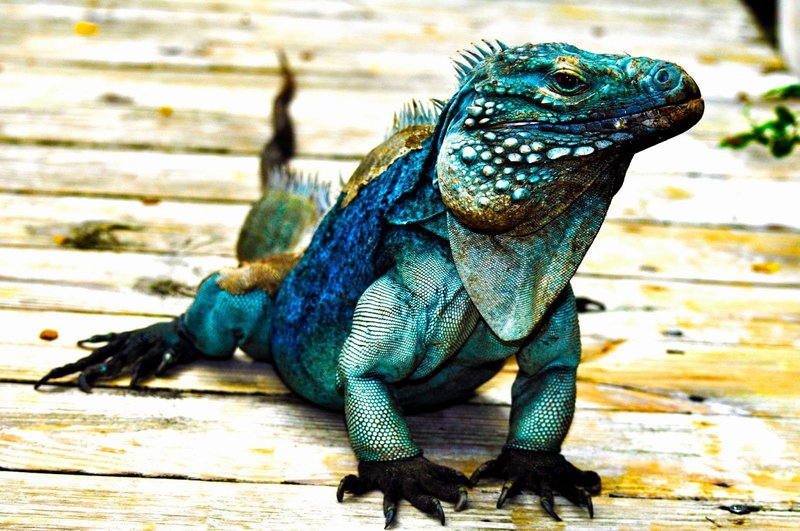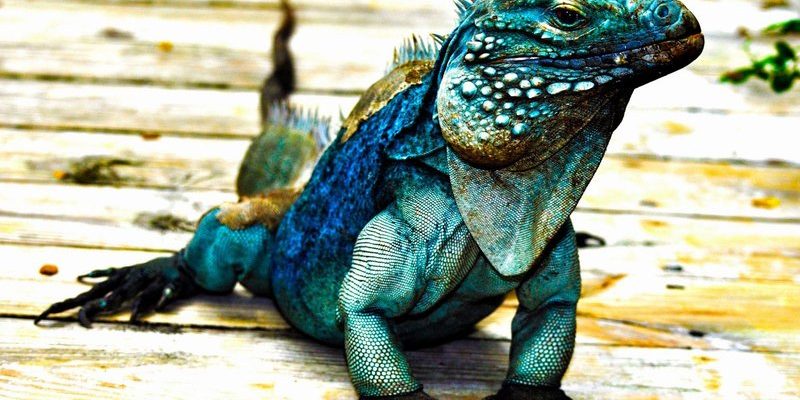
Physical Appearance of Blue Iguanas
When it comes to identifying a blue iguana, its color is the most obvious feature. Adult blue iguanas display a vibrant blue hue that can range from bright turquoise to a deep, rich blue. However, their coloration can shift based on various factors like age and environment. Younger iguanas might not exhibit the same vivid coloration as adults, often appearing more gray or greenish.
Another thing to look out for is their size. Adult blue iguanas can reach lengths of up to 5 feet (1.5 meters), making them quite large compared to other iguana species. Their robust bodies are covered in spiky scales, giving them a somewhat prehistoric look. When you see one basking in the sun, you can’t help but think they might be a distant cousin of dinosaurs!
Don’t forget about their distinctive features. Blue iguanas have a strong jaw and a prominent dewlap, which is the flap of skin under their chin. This dewlap plays an important role in communication and thermoregulation, helping them stay cool in the Caribbean heat. You might see them puff it out occasionally, especially during mating season or when they’re feeling particularly territorial.
Habitat and Range
Blue iguanas are native to the Grand Cayman Island and a few surrounding areas. Their preferred habitats include coastal forests and dry shrublands. They thrive in areas with plenty of sunlight, where they can bask on rocks and trees. If you’re lucky enough to visit the Caribbean, keep your eyes peeled in these environments—you just might spot one!
Now, if you’re wondering about their adaptability, here’s the thing: blue iguanas are nearly exclusively herbivorous. They primarily feed on leaves, flowers, and fruits, making them a vital part of their ecosystem. Their diet not only keeps them healthy but also helps maintain plant life in their habitat. If you see an iguana munching on plants, you can bet it’s likely a blue iguana if it’s in the right area.
Fortunately, conservation efforts have been put into place to protect their habitats, as they face threats from habitat loss, invasive species, and even climate change. So, when you spot one, remember you’re witnessing a creature that’s fighting to survive in an ever-changing environment.
Behavioral Traits
Now, let’s chat about behavior. Blue iguanas can be a bit shy at first. If they sense danger, their instinct is to bolt and hide. Here’s where you might be able to catch a glimpse of their personality. Unlike some other lizard species, blue iguanas tend to be more solitary. They prefer to bask alone rather than in groups.
You might also notice their communication methods. Blue iguanas can be quite vocal, using a variety of sounds and body language to communicate. They may hiss, grunt, or even bob their heads to assert dominance or signal distress. This means if you hear some unusual sounds while observing them, you could very well be catching a moment of iguana dialogue!
Another fascinating aspect is their territorial behavior. Male blue iguanas are known to be particularly territorial and will defend their space against others. Watching them engage in displays of dominance can be quite entertaining. They’ll puff up, expand their dewlap, and even chase off rivals if they feel threatened. It’s like a mini drama unfolding before your eyes!
Distinguishing Features from Other Iguanas
You might be wondering how to tell a blue iguana apart from other iguana species. One notable distinction is their color. While many iguanas can be green or brown, the blue iguana stands out with its bright blue tones. If you see a lizard that seems to shimmer with a blue hue, you’re probably looking at a blue iguana.
Another detail is their head shape and body structure. Blue iguanas have a more robust and muscular build compared to the slender green iguanas. Additionally, their heads are wider and more pronounced, especially in males. Another common comparison is with the lesser Antillean iguanas, which also have vibrant colors but lack the bold blue pigmentation.
When it comes to size, blue iguanas are usually larger than their green cousins. So, if you see a hefty lizard basking in the sun, it’s a good bet it’s a blue iguana if it’s in the right area. This distinction can help anyone trying to identify the species while out in the wild.
Conservation Status and What You Can Do
As stunning as the blue iguana is, it’s important to recognize that their population has been in decline. These reptiles are currently listed as vulnerable due to habitat loss, invasive species, and human interaction. The good news is that conservation efforts are in place, and programs are working to recover their numbers.
So, what can you do to help? If you’re visiting their natural habitat, it’s crucial to respect their space. Avoid disturbing their environment, and follow local guidelines for wildlife watching. Educating yourself about these creatures and advocating for conservation initiatives is another way to make a difference. Every little action counts!
One of the best things about blue iguanas is that they’re now being bred in captivity, which helps bolster their numbers and prevent extinction. Supporting zoos and wildlife organizations that promote these breeding programs can also play a role in their preservation.
Final Thoughts on Blue Iguanas
Identifying a blue iguana is more than just appreciating its vibrant color; it’s about understanding its role in the ecosystem and the challenges it faces. By recognizing their physical traits, behavior, and habitat, you’ll be well-equipped to spot these incredible reptiles should you come across them.
Remember, every encounter with a blue iguana is a reminder of nature’s beauty and fragility. By becoming informed and supporting conservation efforts, you can help ensure that these striking creatures thrive for generations to come. So, the next time you find yourself in the Caribbean, keep an eye out for that dazzling blue hue—you’ll be glad you did!

